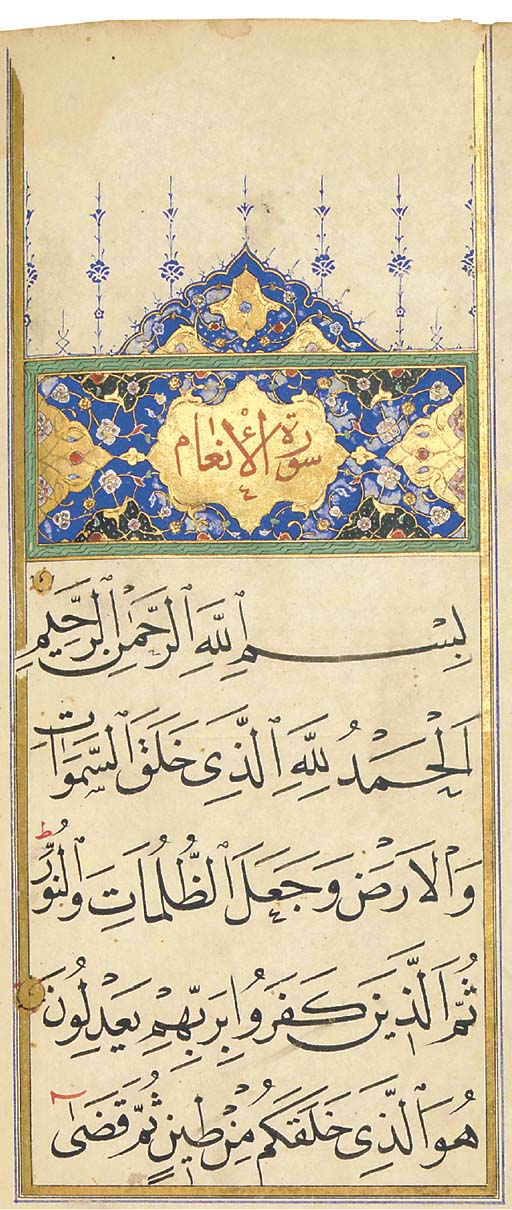

A Qur'an leaf in naskh, Turkey, earlier 1500s
Source: http://www.christies.com/LotFinder/search/LOTDETAIL.ASP?sid=&intObjectID=4272346&SE=CMWCAT03+651718+%2D765185375+&QR=M+1+0+Aqc0000900+620167++Aqc0000900+&entry=india&SU=1&RQ=True&AN=1
(downloaded Apr. 2004)
"QUR'AN SURA AL-AN'AM VI STYLE OF SHAYKH HAMDULLAH, OTTOMAN TURKEY, FIRST HALF 16TH CENTURY. Manuscript on paper, 41ff. with 7ll. of black naskh gold roundels between verses, text within gold rules, opening folio with illuminated heading, every tenth verse with the word 'ashra in magenta in the margin, some water staining, elegant dark maroon morocco binding with flap with tooled medallion. Folio 8 5/8 x 5½in. (21.7 x 14cm.).
Lot Notes: The style of the naskh, the simple marking of the verse count in the margins and the illumination point to a date in the early 16th century for this Qur'an section."

Work of Shaikh Hamdullah, late 1400's
Source: http://www.christies.com/LotFinder/search/LOTDETAIL.ASP?sid=&intObjectID=4272347&SE=CMWCAT03+651851+%2D764840218+&QR=M+1+0+Aqc0000900+620291++Aqc0000900+&entry=india&SU=1&RQ=True&AN=1
(downloaded Apr. 2004)
"QUR'AN COPIED BY SHAYKH HAMDULLAH, OTTOMAN TURKEY, LATE 15TH CENTURY.
Manuscript on paper, 372ff. with 13ll. of very elegant black naskh, vocalisation
in red, gold roundels between verses, sura headings in gold on red hatched
panels with delicate floral illumination, opening finely illuminated bifolio,
preceded by similarly illuminated oval shamsa with pious inscription in
white riqa', verse count, hizb and juz markings written in blue naskh in
margins, final folio with colophon signed Hamdullah known as Ibn al-Shaykh
al-Amasi, ownership note in Turkish below, slight smudging, occasional
added marginal illuminated roundels, some folios loose, in 19th century
tan morocco binding with gold floral tooled design
Folio 6 7/8 x 4 7/8in. (17 x 12.5cm.).
Lot Notes: Beneath the colophon there is a note in Turkish which reads:
Mahmud Han goncasi Abdülaziz Han hazretlerinin Validesi Pertevniyal her kim kiraat ederse hayir dua matlub olunur"The bud of Mahmud Han the mother of his grace Abdülaziz Han whoever reads (the Qur'an) blessing (for her) is demanded."
This note shows that the manuscript was once in the possession of Pertevniyal (d. 1883) the wife of Sultan Mahmud II (r. 1808-39) and the mother of Sultan Abdülaziz (r. 1861-76). She is well-known for her endowments, establishing a waqf and building several fountains, kiosks and schools. Her best known endowments are the Pertevniyal Valide Sultan Mosque (constructed by Sarkis Balyan between 1868-71 in a neo-gothic style) and the Pertevniyal Lyceum in Aksaray.
The colophon
Finished the service of writing (the Qur'an) with the help of God and His success by the weakest of scribes in body and the strongest in sins Hamdullah known as Ibn al-Shaykh al-Amasi praising God and praying for and blessing His Prophet Muhammad and his family the good and the virtuous
The Calligrapher
Shaykh Hamdullah is considered the first great calligrapher of the post-conquest
Ottoman period. He is credited with being the first Ottoman calligrapher
to develop and standardise naskh as the most legible script for use in
Qur'an manuscripts. Shaykh Hamdullah was born in Amasya in the North of
Central
Anatolia in 833/1429 or 840/1456. He was the son of a a shaykh of the Suhrawardi
order from Bukhara in Central Asia who migrated to Amasya. For this reason
he tends to sign himself Ibn al-Shaykh. Hamdullah was also a Sufi, though
he may have changed his allegiance from the Suhrawardis to the Naqshbandis.
He also had a connection to the Halveti order. Many of his pupils and relatives
were connected to this order, and kinship with the Halveti was a characteristic
of calligraphers working in the Shaykh Hamdullah tradition during the reign
of Sultan Sulayman. In addition to being an artist of exceptional talent,
Hamdullah was a considerable sportsman, excelling in archery.
He learned the six scripts from Hayreddin Mar'ashi, a follower of Yaqut
al-Musta'simi and pupil of Abdallah Sayrafi (active 14th century).
Bayezid, later Bayezid II (r. 1481-1512), while governor of Amasya studied calligraphy with Shaykh Hamdullah and on Bayezid's accession as Sultan in 886/1481, the calligrapher became master scribe at the palace in Istanbul. It is reported that the future Sultan had such a repect for the calligrapher that he would hold his inkwell for him while he wrote. Bayezid's relationship with Hamdullah was the impetus that allowed the Shaykh to develop his style. The Sultan made sure that his master calligrapher was very well paid, awarding him the revenues from two villages near Üsküdar in addition to a salary of 30 akçe a day. He was also paid for specific commissions such as the design of calligraphic panels for the mihrab and dome of Bayezid's mosque in Istanbul.
Shaykh Hamdullah spent most of his career in making copies of the Qur'an, and is said to have made forty-seven examples as well as other works of a religious nature and calligraphic exercises. His son Mustafa Dede was his pupil and also a noted calligrapher. A fine illuminated Qur'an by the son was sold in these rooms, 1 May 2001, lot 30.
The illumination
With the exception of the opening bifolio, the illumination of this Qur'an is sparse. The sura headings are in a simple gold riqa' on a red-hatched ground lightly highlighted with simple floral motifs. The margins are plain with the verse count and sajda marked simply by the words written in blue. These features may also be seen in a Qur'an ascribed to Iran or Turkey in the Nasser D. Khalili collection dated to 1450-1500. (James, no. 18, pp. 70-75). A Qur'an in the Library of the Shrine of the Imam Reza at Mashhad written in naskh by Yaqut al-Musta'simi and dated 686/1287 is similar in both the sura headings and the use of verse count and shows the origins of Hamdullah's style. (Lings, pl. 28). These features suggest an early date in Hamdullah's career, perhaps while he was still in Amasya, around 1475-1480.
Derman, M.U.: Letters in gold, Ottoman Calligraphy from the Sakip Sabanci
Collection, Istanbul, New York, 1998, pp. 19, 46-48, nos. 1, 2
James, D.: After Timur, Oxford, 1992
Lings, M.: The Qur'anic art of Calligraphy and Illumination, London
1976
Raby, J.: Turkish Bookbinding in the 15th century, London, 1993, pp.
96-100, no. 40
Safwat,N.F.: The Art of the Pen, Oxford, 1996."